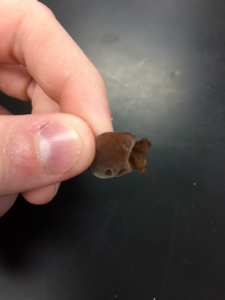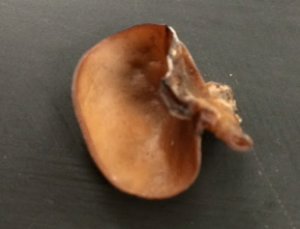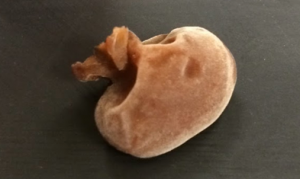Possible ID: Auricularia auricula
Auricularia auricula, otherwise known as the “Jelly Ear,” is a somewhat gelatinous mushroom that is usually ear-shaped or shaped somewhat like a little cup.1,2 Consequently, because of the elastic, jelly-like texture of its flesh, this mushroom is considered to be a jelly mushroom.1 However, even though this mushroom does not taste like jelly, it is, in fact, still edible.2,3
Phylogenetically, Auricularia auricula is a basidiomycete contained in the order Auriculariales and the family Auriculariaceae.1,2 Canonically, Agaricomycetes, which are the “true mushroom-forming” fungi, once excluded jelly fungi, but after the advent of more advanced molecular techniques, it was found that Auricularia auricula actually belongs in this class with the other Agaricomycetes. Furthermore, Auricularia auricula utilizes ballistospory as its spore dispersal mechanism, which is a very common trait among basidiomycetes that takes advantage of the water tension between water droplets by using it as the motive force to launch their spores from their hymenium.1 After releasing its spores, Auricularia auricula will produce a white spore print.1,2
Auricularia auricula is very common in North America, and the sample my group and I collected on April 2nd, 2018, was found on a rotting hardwood tree that had fallen over on a ridge near Turtle Creek park in Lewisburg, PA. This jelly fungus is a saprobic, white-rot fungus on hardwoods and conifers, which means that it can easily be found on trees, stumps, and decaying logs or sticks.1,2 Auricularia auricula is typically gregarious,2 and the sample shown below was found alongside a few other Auricularia auricula fungi. Unfortunately, pictures of the retrieval site were not taken.
As mentioned previously, the fruiting body of Auricularia auricula is typically somewhat ear-shaped,1,2 which can be seen by my sample. When feeling its flesh, my Auricularia auricula fungus was somewhat gelatinous and rubbery.1 Also, the color of Auricularia auricula fruiting bodies can range from a yellowish to a dark purplish brown, 1,2 and as you can see in my sample, the fruiting body was somewhat brownish. My Auricularia auricula sample had a very short stipe (stalk), and its pileus (cap) was somewhat hairy on its upper, sterile surface, while its hymenium on the inner, downward-facing surface was pretty smooth with a couple folds in it.2 Also, gills were not observed in the hymenium. Furthermore, because Auricularia auricula fruiting bodies are typically 2-15 cm wide,1 my fungal sample was on the smaller side around 1.5 cm.
Collector: Tommy Brouse Group: Andriana, Tommy, AJ
Sample pictures:

 .
. 
*On a side note, this jelly fungus can also be called Auricularia auricula-judae and is sometimes referred to as the “Judas’ ear,” or even the “Jew’s ear,” fungus.1,2 Auricularia auricula-judae is often found on elder trees, and its name originally stems from the belief that the apostle Judas Iscariot hung himself from an elder tree.2 However, many people will only refer to this mushroom as “Auricularia auricula” to avoid the political incorrectness of the anti-Semitism that surrounds its original scientific name.1
References
1http://www.mushroomexpert.com/auricularia_auricula.html
2http://www.messiah.edu/Oakes/fungi_on_wood/cup%20and%20saucer/species%20pages/Auricularia%20auricula.htm
3http://www.specialtyproduce.com/produce/Wood_Ear_Mushrooms_720.php